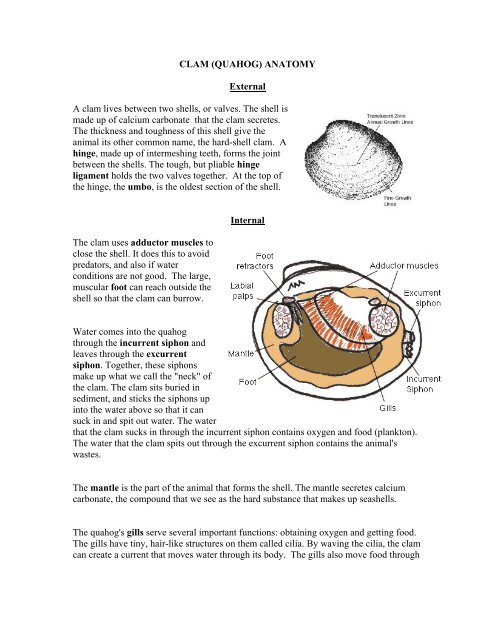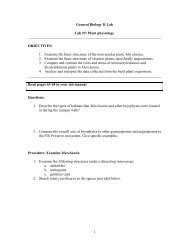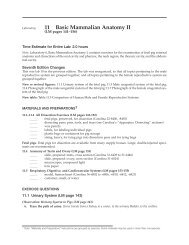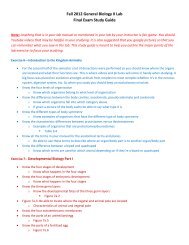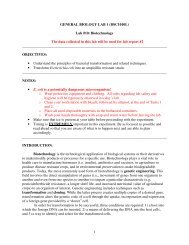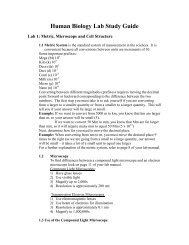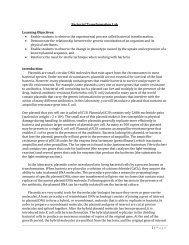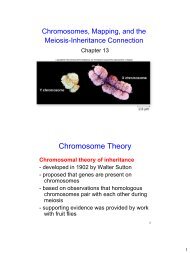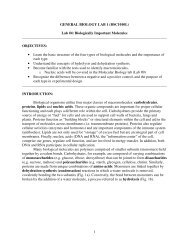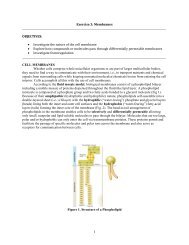You also want an ePaper? Increase the reach of your titles
YUMPU automatically turns print PDFs into web optimized ePapers that Google loves.
<strong>CLAM</strong> (<strong>QUAHOG</strong>) <strong>ANATOMY</strong><br />
External<br />
A clam lives between two shells, or valves. The shell is<br />
made up of calcium carbonate that the clam secretes.<br />
The thickness and toughness of this shell give the<br />
animal its other common name, the hard-shell clam. A<br />
hinge, made up of intermeshing teeth, forms the joint<br />
between the shells. The tough, but pliable hinge<br />
ligament holds the two valves together. At the top of<br />
the hinge, the umbo, is the oldest section of the shell.<br />
The clam uses adductor muscles to<br />
close the shell. It does this to avoid<br />
predators, and also if water<br />
conditions are not good. The large,<br />
muscular foot can reach outside the<br />
shell so that the clam can burrow.<br />
Internal<br />
Water comes into the quahog<br />
through the incurrent siphon and<br />
leaves through the excurrent<br />
siphon. Together, these siphons<br />
make up what we call the "neck" of<br />
the clam. The clam sits buried in<br />
sediment, and sticks the siphons up<br />
into the water above so that it can<br />
suck in and spit out water. The water<br />
that the clam sucks in through the incurrent siphon contains oxygen and food (plankton).<br />
The water that the clam spits out through the excurrent siphon contains the animal's<br />
wastes.<br />
The mantle is the part of the animal that forms the shell. The mantle secretes calcium<br />
carbonate, the compound that we see as the hard substance that makes up seashells.<br />
The quahog's gills serve several important functions: obtaining oxygen and getting food.<br />
The gills have tiny, hair-like structures on them called cilia. By waving the cilia, the clam<br />
can create a current that moves water through its body. The gills also move food through
the body. When water comes in through the incurrent siphon, particles of silt and food are<br />
trapped on the layer of mucous on the outer surface of the gills.<br />
From there, the cilia move the particles<br />
along food grooves toward the labial palps,<br />
where they are sorted. Food particles move<br />
on toward the mouth. Other particles—such<br />
as silt or excess phytoplankton—are<br />
dropped onto the surface of the mantle,<br />
where the clam eventually gets rid of them<br />
in mucous-coated balls. Food particles<br />
move from the mouth and esophagus to a<br />
multi-chambered stomach with numerous<br />
passageways and dead-end sacs.<br />
Located inside the muscular foot are the<br />
intestines, digestive glands, and gonads.<br />
The quahog has an "open" circulatory system, so that once the hemolymph gets to the<br />
outer tissues, it leaves the blood vessels and flows into open sinuses, or cavities, where it<br />
directly bathes the tissues. In contrast, in our circulatory systems, blood always stays in<br />
some kind of blood vessel, such as capillaries.<br />
<strong>CLAM</strong> DISSECTION<br />
1. Identify the following external structures: umbo, shell, hinge<br />
2. To open the clam, you have to cut through the 2 adductor muscles with the scalpel.<br />
Insert your scalpel before the hinge on one side and move it towards the hinge until<br />
you feel resistance. Then using a slicing motion, keep pushing the scalpel forward<br />
until you are through the muscle. Do the same on the other side<br />
3. Once the adductor muscles are cut, slowly and carefully pry open the shells so you<br />
can see the internal structures<br />
4. Once the shells are pulled open so they are horizontal, identify the following internal<br />
structures: gills, foot, mantle, labial palps<br />
5. To open the foot, run the scalpel the long way through the foot so you can see inside.<br />
Identify the following structures: digestive glands (greenish mass), intestine, gonads<br />
(yellowish mass)<br />
Reference<br />
http://seagrant.gso.uri.edu/G_Bay/HabitatEco/Shellfishing/quahog_dissect.html


